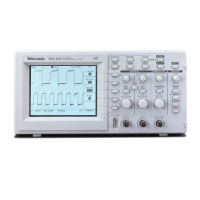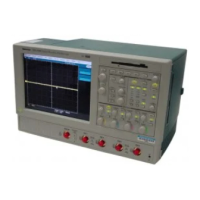Pinpoint Trigge
rs
Auto mode, when forcing triggers in the absence of valid triggering events, does not synchronize the waveform on the
display. The w a
veform will appear to roll across the screen. If valid triggers occur, the display will become stable.
You can also for
ce the instrument to trigger with an edge trigger by clicking the Force Trigger button on the Trigger Setup
control window.
Trigger Holdoff
Trigger holdoff can help stabilize triggering. When the instrument recognizes a trigger event, it disables the trigger system
until acquisition is complete. In addition, the trigger system r emains disabled during the holdoff period that follows each
acquisition. Adjust holdoff to obtain stable triggering when the instrument is triggering on undesired trigger events.
Trigger Coupling
Trigger coupling determines what part of the signal is passed to the trigger circuit. Edge triggering can use all available
coupling types: AC, DC, Low Frequency Rejection, High Frequency Rejection, and Noise Rejection. All other trigger
types use DC
coupling only.
Horizontal Position
Horizontal position is an adjustable feature that defines where the trigger occurs on the waveform record. It lets you choose
how much the instrument acquires before and after the trigger event. The part of the record that occurs before the trigger is
the pretrigger portion. The part that occurs after the trigger is the posttrigger portion.
Pretrigger data can be valuable when troubleshooting. For example, if you are trying to find the cause of an unwanted glitch
in your test circuit, you can trigger on the glitch and make the pretrigger period large enough to capture data before the
glitch. By analyzing what happens before the glitch, you may uncover information that helps you find the source of the glitch.
Alternatively, if you want to see what is happening in your system as a result of the trigger event, make the posttrigger period
large enough to capture data after the trigger.
Slope and Level
The slope control determines whether the instrument finds the trigger point on the rising or the falling edge of a signal. The
level control determines where on that edge the trigger point occurs.
Delayed T
rigger System
You can trigger with the A (Main) trigger system alone or you can combine the A (Main) trigger with the B (Delayed) trigger
to trigger on sequential events. When using sequential triggering, the A trigger event arms the trigger system, and the B
trigger event triggers the instrument when the B trigger conditions are met. A and B triggers can (and typically do) have
separate sources. The B trigger condition can be based on a time delay or a specified number of events. (See page 33,
Using A (Main) and B (Delayed) Triggers.)
TDS6000B & TDS6000C Series Quick Start User Manual 29

